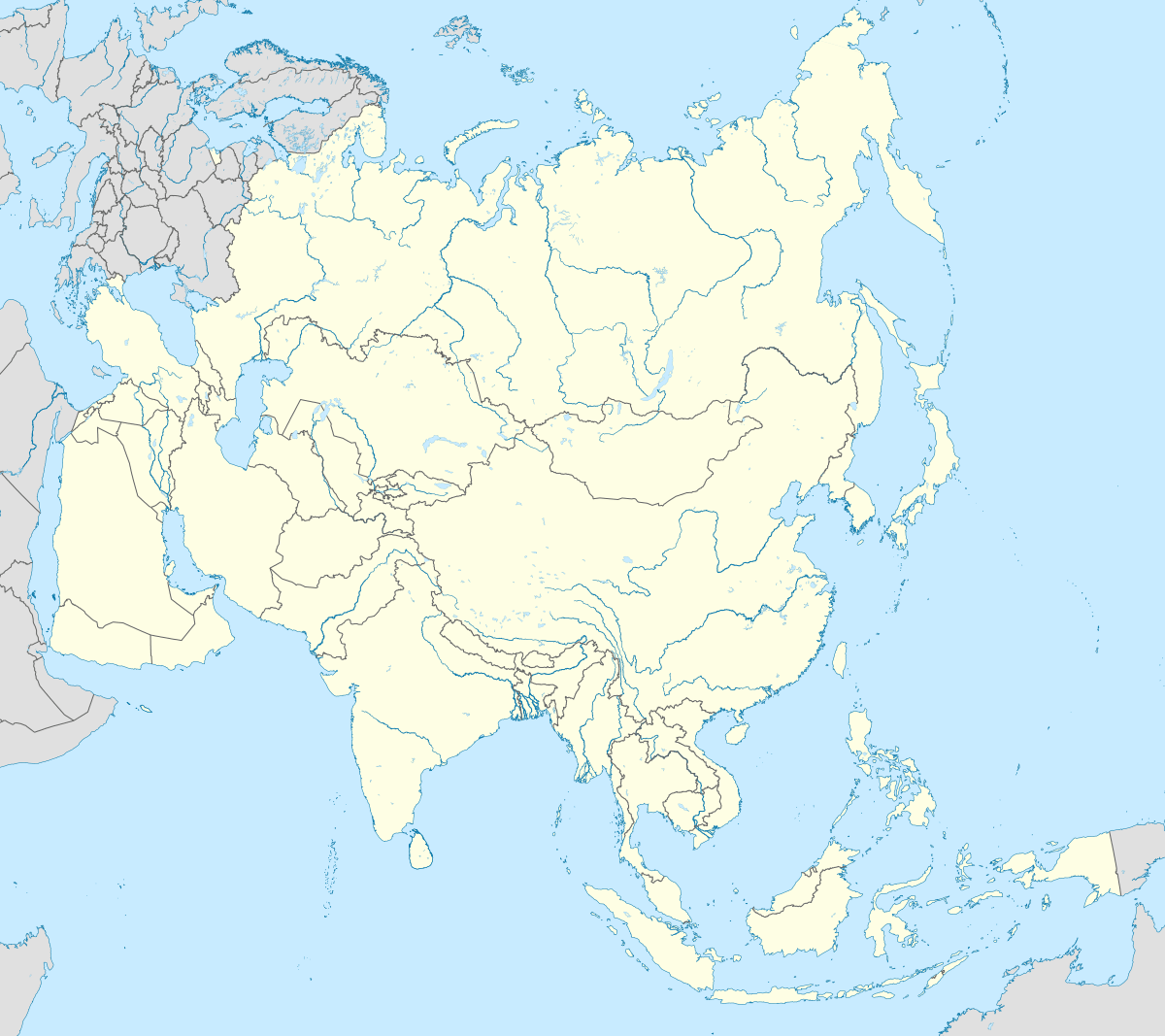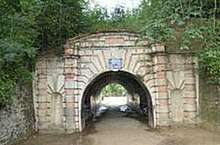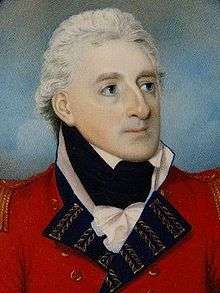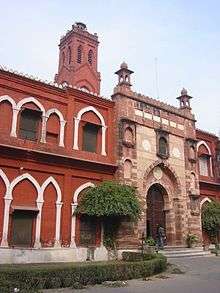Aligarh
Aligarh ( (![]()
Aligarh Kol | |
|---|---|
 | |
 Aligarh Location in Uttar Pradesh, India  Aligarh Aligarh (India)  Aligarh Aligarh (Asia) | |
| Coordinates: 27.88°N 78.08°E | |
| Country | |
| State | Uttar Pradesh |
| Division | Aligarh |
| District | Aligarh |
| Government | |
| • Type | Municipal corporation |
| • Body | Aligarh Nagar Nigam |
| • Mayor | Mohammad Furqan, (BSP) |
| Elevation | 178 m (584 ft) |
| Population (2011)[1] | |
| • Total | 874,408 |
| • Rank | 55 |
| Demonym(s) | Aligarian |
| Language | |
| • Official | Hindi[2] |
| • Additional official | Urdu[2] |
| • Regional | Braj Bhasha |
| Time zone | UTC+5:30 (IST) |
| PIN | 202001,202002 |
| Telephone code | 0571 |
| Vehicle registration | UP-81 |
| Website | aligarh |
The recorded history of Aligarh begins with the establishment of the Aligarh Fort in the 16th century. It is a university town, notable as the seat of Aligarh Muslim University, which was founded here as Muhammadan Anglo-Oriental College in 1875, initiating the Aligarh movement.
History

Before the 18th century, Aligarh was known as Kol. The history of the district up until the 12th century is obscure.[3]
Sometime before the Muslim conquest, Kol was held by the Dor Rajputs. At the time of Mahmud of Ghazni, the chief of the Dors was Hardatta of Baran. Statues of Buddha and other Buddhist remains have been found in excavations where the citadel of Koil stood, indicating a Buddhist influence. Hindu remains indicate that the citadel probably had a Hindu temple after the Buddhist temple. In 1194, Qutb-ud-din Aibak marched from Delhi to Kol, "one of the most celebrated fortresses of Hind". Qutb-ud-din Aibak appointed Hisam-ud-din Ulbak as the first Muslim governor of Kol.
Kol is mentioned in Ibn Battuta's Rihla, when Ibn Battuta along with 15 ambassadors representing Ukhaantu Khan, emperor of the Mongol Chinese Yuan dynasty, travelled to Kol city en route to the coast at Cambay (in Gujarat) in 1341.[4] According to Battuta, it would appear that the district was then in a very disturbed state since the escort of the Emperor's embassy had to assist in relieving Jalali from an attacking body of Hindus and lost an officer in the fight. Ibn Batuta calls Kol "a fine town surrounded by mango groves". From these same groves the environs of Kol would appear to have acquired the name Sabzabad or "the green country".
In the reign of Akbar, Kol was made a Sirkar and included the dasturs of Marahra, Kol ba Haveli, Thana Farida and Akbarabad. Akbar and Jahangir visited Kol on hunting expeditions. Jahangir clearly mentions the forest of Kol, where he killed wolves.[3]
During the time of Ibrahim Lodhi, Muhammad, son of Umar, was the governor of Kol. He built a fort at Kol and named the city Muhammadgarh, after himself, in 1524–25. Sabit Khan, who was then the governor of this region, rebuilt the old Lodhi fort and named the town Sabitgarh, after himself.
The ruler of Koil was Bargujar King Rao Bahadur Singh who, in 1753, rose against the destruction of Hindu temples. The Jat ruler, Surajmal, with help from Jai Singh of Jaipur and the Muslim army, occupied the fort of Koil. Bahadur Singh continued the battle from another fort and died fighting in what is known as the "Battle of Ghasera". It was renamed Ramgarh and finally, when a Shia commander, Najaf Khan, captured Kol, he gave it its present name of Aligarh. Aligarh Fort (also called Aligarh Qila), as it stands today, was built by French engineers under the control of French officers Benoît de Boigne and Perron.[3]
Battle of Aligarh (1803)

The Battle of Aligarh was fought on 1 September 1803 during the Second Anglo-Maratha War (1803–1805) at Aligarh Fort. The British 76th Regiment, now known as the Duke of Wellington's Regiment besieged the fort, which was under the control of the French officer Perron, and established British rule. In 1804, the Aligarh district was formed by the union of the second, third and fourth British divisions with the addition of Anupshahr from Muradabad and Sikandra Rao from Etawa. On 1 August 1804, Claude Russell was appointed the first Collector of the new district.[5]
Administration
Aligarh district is divided into five tehsils, namely Kol Tehsil, Khair Tehsil, Atrauli, Gabhana and Iglas. These tehsils are further divided into 12 blocks.
The city is administered by Nagar Nigam Aligarh (Municipal Corporation), which is responsible for performing civic administrative functions administered by Mayor and Municipal Commissioner (PCS Officer). Infrastructure development of the city is looked after by the Aligarh Development Authority (ADA) administered by Divisional Commissioner (Chairman) and Vice-Chairman (PCS Officer).
Aligarh is the headquarters of Aligarh Police Range and Aligarh Division. A DIG looks after Aligarh for legal condition and law; a Commissioner looks for four districts of Aligarh Division (Aligarh, Etah, Hathras, Kasganj).
Demographics
According to the 2011 Census, Aligarh has a total population of 874,408, of which 461,772 are males and 412,636 are females. Population in the age range 0–6 years is 119,543. The literacy rate is 59.15%, of which the male literacy rate is 63.42% and female literacy rate is 54.37%. The effective literacy rate of 7+ population of Aligarh was 68.5%, of which male literacy rate was 62.9% and the female literacy rate was 70.8%The Scheduled Castes and Scheduled Tribes have a population of 138,184 and 332 respectively. There were 147363 households in Aligarh as of 2011.[1]
Geography
Location
Aligarh is located at the coordinates 27.88°N 78.08°E.[6] It has an elevation of approximately 178 metres (587 feet). The city is in the middle portion of the doab, the land between the Ganges and the Yamuna rivers. The Grand Trunk Road passes through it via NH-91 is 134 km from capital of India.
Climate
Aligarh has a monsoon-influenced humid subtropical climate, typical of north-central India. Summers start in April and are hot with temperatures peaking in May. The average temperature range is 28–38 °C (82–100 °F). The monsoon season starts in late June, continuing till early October, bringing high humidity. Aligarh gets most of its annual rainfall of 800 millimetres (31 in) during these months. Temperatures then decrease, and winter sets in December, and continues till February. Temperatures range between 5–11 °C (41–52 °F). Winters in Aligarh are generally mild, but 2011–12 experienced the lowest temperature of 1 °C. The fog and cold snaps are extreme.
| Climate data for Aligarh (1981–2010, extremes 1932–2011) | |||||||||||||
|---|---|---|---|---|---|---|---|---|---|---|---|---|---|
| Month | Jan | Feb | Mar | Apr | May | Jun | Jul | Aug | Sep | Oct | Nov | Dec | Year |
| Record high °C (°F) | 30.7 (87.3) |
33.3 (91.9) |
41.7 (107.1) |
44.8 (112.6) |
47.5 (117.5) |
46.7 (116.1) |
44.5 (112.1) |
42.1 (107.8) |
40.2 (104.4) |
41.7 (107.1) |
36.1 (97.0) |
32.8 (91.0) |
47.5 (117.5) |
| Average high °C (°F) | 19.8 (67.6) |
23.5 (74.3) |
30.3 (86.5) |
37.0 (98.6) |
40.1 (104.2) |
39.2 (102.6) |
35.3 (95.5) |
33.4 (92.1) |
33.6 (92.5) |
32.8 (91.0) |
27.9 (82.2) |
22.3 (72.1) |
31.3 (88.3) |
| Average low °C (°F) | 7.1 (44.8) |
9.5 (49.1) |
14.3 (57.7) |
19.9 (67.8) |
24.2 (75.6) |
26.3 (79.3) |
26.0 (78.8) |
25.2 (77.4) |
23.5 (74.3) |
18.4 (65.1) |
12.6 (54.7) |
8.3 (46.9) |
18.0 (64.4) |
| Record low °C (°F) | 0.0 (32.0) |
1.7 (35.1) |
3.9 (39.0) |
10.9 (51.6) |
15.5 (59.9) |
18.6 (65.5) |
19.9 (67.8) |
19.9 (67.8) |
14.8 (58.6) |
11.0 (51.8) |
2.9 (37.2) |
1.2 (34.2) |
0.0 (32.0) |
| Average rainfall mm (inches) | 13.4 (0.53) |
15.4 (0.61) |
9.1 (0.36) |
9.8 (0.39) |
29.0 (1.14) |
65.8 (2.59) |
207.4 (8.17) |
234.5 (9.23) |
112.2 (4.42) |
19.7 (0.78) |
4.3 (0.17) |
7.2 (0.28) |
727.7 (28.65) |
| Average rainy days | 1.3 | 1.4 | 1.0 | 0.9 | 2.6 | 3.9 | 9.0 | 10.4 | 5.9 | 0.9 | 0.5 | 0.7 | 38.3 |
| Average relative humidity (%) (at 17:30 IST) | 64 | 56 | 46 | 32 | 34 | 46 | 67 | 75 | 67 | 53 | 57 | 61 | 55 |
| Source: India Meteorological Department[7][8] | |||||||||||||
Economy
The city is an agricultural trade centre.[9] Agricultural product processing and manufacturing are important.[10]
Aligarh is an important business center of Uttar Pradesh and is most famous for its lock industry. Aligarh locks are exported across the world. In 1870, Johnson & Co. was the first English lock firm in Aligarh. In 1890, the company initiated production of locks on a small scale here.[11]
Aligarh is famous for its brass hardware and sculpture. Today, the city holds thousands of manufacturers, exporters, and suppliers involved in the brass, bronze, iron and aluminum industries.
Harduaganj Thermal Power Station (also referred as Kasimpur Power House) is 15 km from the city. Narora Atomic Power Station is located 50 km from Aligarh.
Aligarh hosts Heinz-sauce manufacturing unit in Manzurgarhi, Satha sugar mill on the Aligarh-Kasimpur Power House route and a cement factory of UltraTech Cement company.
Wave Distillery, making Kingfisher beer, is located at Atrauli in Aligarh.
Education
Aligarh is a major educational hub, housing over 100 independent colleges and educational institutions. Notable institutions include:
The city is also a schooling and coaching hub for preparation to enter college. Our Lady of Fatima High School, Aligarh is the oldest English medium school with many notable alumni.
Locations
Cultural landmarks

Aligarh has several popular landmarks. Most notable few of them are Aligarh fort, Khereshwar Temple which is the birthplace of Swami Shri Haridas Ji, Teerthdham Mangalayatan Mandir and Dor fortress (1524), which is now in ruins, lies at the city's centre; its site is in the area now called Upper Fort (Balai Qila) and is occupied by an 18th-century mosque. The area Shah Jamal is very famous for a Sufi saint Syed Shah Jamal is also known as Shamsul Arifeen, of whom the tomb is located at Shahjamal area and surrounded by a graveyard. The Sufi Saint is mentioned by Ibn Battuta in his book The Travels of Ibn Battuta. The saint is said to be of Sufi Chishtiya order.
The Annual Cultural Exhibition, popularly known as Numaish, is held at the exhibition ground in January and February. The land Numaish Ground was donated By Nawab Rehmat Ullah Khan Sherwani. The cultural shows take place at three grand stages (Kohinoor, Krishnanjali and Muktakash). In all, more than 150 stage events featuring artists from across India take place during a period of 28–30 days.[12]
Historical places

- Shekha Jheel, Bird Sanctuary
- Maulana Azad Library, AMU (Estd 1875)
- Sir Syed Masjid in Aligarh Muslim University's campus.
Aligarh Muslim University
Aligarh Muslim University (AMU) is one of the oldest central universities. It was established by Sir Syed Ahmed Khan as Madrasatul Uloom Musalmanan-e-Hind in 1875–78 which later became Mohammedan Anglo-Oriental College (MAO College). It was designed to train Muslims for government services in India and prepare them for advanced training in British universities. The Mohammedan Anglo-Oriental College became Aligarh Muslim University in 1920. It is famous for its Law, Medical, and Engineering College.
Museums
Ibn Sina Academy of Medieval Medicine and Sciences maintains 'Museum on History of Medicine and Sciences' and 'Museum on Arts, Culture and Orientalism'. It was established by a family Hakim Syed Zillur Rahman and Syed Ziaur Rahman at the heart of the city and near a busy market of Dodhpur.[13][14]
Transport
By rail

Aligarh Junction railway station is the primary station for Aligarh city and is a major stop on the Delhi-Kolkata route. It is an A-Class railway station. It is one of the oldest railway station of this route. It connects Aligarh to the states of West Bengal, Odisha, Bihar, Jharkhand, north-east and most of Uttar Pradesh, and important stations of cities such as New Delhi railway station, Mumbai Central, Kolkata, Bhopal Junction railway station, Indore, Jammu, Gwalior, Lucknow, Jhansi, Puri, Kanpur Central railway station, Etawah Junction railway station, Tundla Junction railway station, Agra Cantonment railway station and Varanasi. Aligarh railway station handles over 136 trains daily (in both directions) and serves around 204,000 passengers every day. Aligarh has one Branch Railway Line to Bareily.
Aligarh City has following railway stations:
- Aligarh Junction: an A-Class Railway Station
- Somna (Gabhana) railway station
- Mahrawal railway station
- Kalua railway station
- Daudkhan railway station
- Mandrak railway station
- Harduaganj railway station (Satha, near Kasimpur Power House)
- Manjoorgarhi railway station (Chherat)
By road
Aligarh is 140 km from New Delhi. It is one of the Division of UPSRTC. Uttar Pradesh State Road Transport Corporation (UPSRTC) buses serve cities all over the state and cities in Uttarakhand, Rajasthan, Madhya Pradesh and Haryana.
Aligarh City has two UPSRTC bus stations:
- Aligarh Depot bus station
- Masoodabad (Budh Vihar) Depot bus station
- ISBT Rasualabad Sarsaul under construction
There are buses plying from Aligarh to Delhi at frequent intervals via
1) Khair, Tappal, Palval, Faridabad, Delhi - The route is under construction between Khair and Palval and should be strictly avoided by cars. No toll charges.
2) Khair, Tappal, Yamuna expressway, Noida, Greater Noida, Delhi, Gurgaon - Best and recommended route for Delhi, Noida, Gurgaon. Toll Charges are ₹120 between Aligarh and Delhi.
3) Old GT Road, Bulandshahr, Ghaziabad, Delhi - NH 91 - It is a 4-lane highway. Toll charges are ₹190.
Following Highways are connected to Aligarh:
- National Highway 91 - It connects Kolkata to national capital New Delhi. Ghaziabad-Bulandshahr-Aligarh section is a 4-Lane Highway.
- National Highway 93 - It connects Moradabad to Taj Nagri Agra via Aligarh. Aligarh-Agra section is constructed as Brijbhoomi Expressway.
- Yamuna Expressway - It is a 6-Lane Expressway connecting Greater Noida with Agra.
Aligarh City has Mahanagar Bus Service (City Bus Service) which provides local transport to Aligarh.
- Route-1 J N Medical-Uperkot
- Route-2 Gandhi Park-Sarsaul
- Route-3 Ghantarbagh-Quarsi
- Route-4 Gandhi Park-Boner
- Route-5 Etah Chungi-Collectrate
By air
The nearest international airport from Aligarh is Indira Gandhi International Airport, New Delhi. It is 140 km from Aligarh.
Aligarh Airport, in Dhanipur, is under construction on NH 91. Dhanipur Air Strip is used as Flying Club. The Government of Uttar Pradesh signed a memorandum of understanding with the Airports Authority of India in February 2014 for the development of the airport. The land acquisition for airport will be initiated soon and after its development flight operations will be started under regional connectivity scheme.
Inter-city transport
The government has proposed to operate city buses in Aligarh with following routes:
- Aligarh Fort–Law Faculty–Firdaus Nagar–Shamshad–Collectorate–University Circle–Lal Diggi Lake–Amir Nishan–Marris Road Crossing–Kela Nagar Crossing–Chungi/Ramghat Road–Quarsi Crossing–Indrapuri/Great Mall–Mahaveer Nagar–DPS Civil Lines–St. Fidelis–Heritage–UPSIDC Harduaganj
- Bannadevi Crossing–Methodist Church–Exhibition Ground–RMPS Park–Ghantaghar–Centre Point–Melrose-Marris Road Crossing–Kela Nagar Crossing
- Railway Station–Ghantaghar Circle–Tibiyya College–Lal Diggi Lake–Amir Nishan–Marris Road Crossing–Kela Nagar Crossing–Chungi/Ramghat–Quarsi Crossing–Jeevangarh–Dhorra–Jamalpur–Ayesha Tarin School
Notable people
Businessmen and entrepreneurs
- Vijay Shekhar Sharma, founder of Paytm
- Sheela Gautam, founder of Sheela Foam Limited-Sleepwell.
Educationalists

- Sir Ziauddin Ahmad, Mathematician, M.L.A. (Central), Vice-Chancellor of Aligarh Muslim University Movement. He established several institution including J.N. Medical College.
- Sir Syed Ahmad Khan founder of Aligarh Muslim University
Writers, poets and publishers
- A.R. Akela, Dalit author and publisher, owner of "Anand Sahitya Sadan
- Syed Amin Ashraf, Urdu poet and professor of English at AMU
- Qurratulain Hyder, Padma Bhushan, Urdu novelist, writer, and journalist
- Akhlaq Mohammed Khan, pen name Shaharyar, Urdu poet, Bollywood lyricist and served as Professor at Aligarh Muslim University
- Munshi Nawal Kishore, book publisher
- Jainendra Kumar, Hindi writer
- Gopaldas Neeraj, poet, recipient of Padma Bhushan
- Saghar Nizami, Urdu Poet
- Prem Kishore Patakha, Hindi Humorous Poet
- Maitreyi Pushpa, Hindi fiction writer
- Rameshraj Tewarikar, Hindi Tewari poet, Editor:′ Tewari-Paksha (tri-monthly)
Historians

- Irfan Habib, eminent Indian historian and Professor Emeritus at Aligarh Muslim University
- Mohammad Habib (1895–1971), noted Indian historian and served as Professor Emeritus at Aligarh Muslim University
Film actors
- Shamim Ara, Pakistani film actress
- Bharat Bhushan, Bollywood actor, scriptwriter and producer
- Aadesh Chaudhary, Indian television actor
- Nitin Chauhaan, Indian television actor
- Ravindra Jain, Bollywood music director
- Vierendrra Lalit, Bollywood film director-cinematographer.
- Chandrachur Singh, Bollywood actor
- Hasan Zaidi, Indian television actor
- Zarina, Indian artist
Sports persons
- Piyush Chawla, Indian cricketer
- Zafar Iqbal, Former hockey captain of India
- Annu Raj Singh, international shooter
- Rinku Singh, Cricketer
Politicians
- Satish Kumar Gautam, current MP from, Aligarh (Lok Sabha constituency)
- Sheela Gautam, Ex MP & owner of Sleepwell
- Jamal Khwaja, Ex MP
- Sanjeev Raja, Current MLA
- Bijendra Singh, Ex MP
- Chaudhary Sunil Singh, Ex MLC
- Dalbir Singh Chaudhary, MLA from Baruli vidhansabha constituency
- Rajendra Singh, Ex Agriculture and Irrigation Minister, Govt of Uttar Pradesh
- Sandeep Singh, MLA Atrauli, grandson of Sh. Kalyan Singh
- Thakur Jaivir Singh, Ex MLA (Now MLC)
Medical professionals
- Khwaja Abdul Hamied, Pharmacist, founder of Cipla (pharmaceutical company)
- Hakim Syed Zillur Rahman, Unani physician and author
- Ashok Seth, an Indian interventional cardiologist
Social activists
- Jai Kishan Das, a close associate of Sir Syed Ahmad Khan
- Rajiv Dixit, Indian social activist
References
- "Census of India: Search Details". www.censusindia.gov.in. Retrieved 29 September 2019.
- "52nd REPORT OF THE COMMISSIONER FOR LINGUISTIC MINORITIES IN INDIA" (PDF). nclm.nic.in. Ministry of Minority Affairs. Archived from the original (PDF) on 25 May 2017. Retrieved 20 December 2018.
- "Histor11". Aligarhdirectory.com. Archived from the original on 11 October 2004. Retrieved 29 July 2015.
- The Adventures of Ibn Battuta, by Ross E. Dunn, p. 215
- Edwin T. Atkinson (1875). Descriptive and Historical Account of the Aligarh District. p. 348. Archived from the original on 5 July 2014. Retrieved 13 October 2011.
- "Falling Rain Genomics, Inc – Aligarh". Fallingrain.com. Archived from the original on 11 October 2011. Retrieved 13 October 2011.
- "Station: Aligarh Climatological Table 1981–2010" (PDF). Climatological Normals 1981–2010. India Meteorological Department. January 2015. pp. 27–28. Archived from the original (PDF) on 5 February 2020. Retrieved 27 April 2020.
- "Extremes of Temperature & Rainfall for Indian Stations (Up to 2012)" (PDF). India Meteorological Department. December 2016. p. M210. Archived from the original (PDF) on 5 February 2020. Retrieved 27 April 2020.
- "India9.com". India9.com. 7 June 2005. Archived from the original on 10 May 2013. Retrieved 13 October 2011.
- "Britannica". Britannica. Archived from the original on 18 November 2008. Retrieved 13 October 2011.
- Pawan JainPawan Jain (3 June 2003). "Times of India". Timesofindia.indiatimes.com. Archived from the original on 7 June 2011. Retrieved 13 October 2011.
- "Dainik Jagran". Epaper.jagran.com. 29 January 2015. Archived from the original on 21 May 2015. Retrieved 29 July 2015.
- "World's 10 weirdest medical museums". Bryan Pirolli for CNN, Travel (24 May 2013). 16 May 2013. Archived from the original on 14 March 2017. Retrieved 17 December 2017.
- "Ibn Sina Academy". Eram Agha for CNN-News18, (5 November 2017). Archived from the original on 10 November 2017. Retrieved 17 December 2017.
Further reading
- Aligarh in My Days (Interviews of former Vice-Chancellors of Aligarh Muslim University), Ed. Syed Ziaur Rahman, Non-Resident Students' Centre, Aligarh Muslim University, Aligarh, 1997.
- Atkinson, Edward (2010) [1875]. Descriptive And Historical Account of the Aligarh District. Nabu Press. ISBN 978-1-147-42719-6.
| Wikiquote has quotations related to: Aligarh |